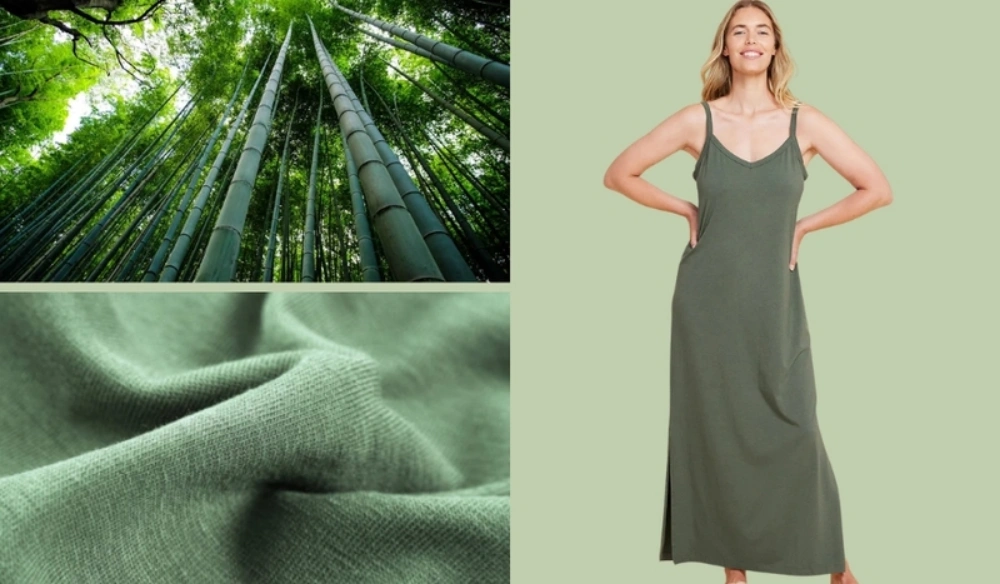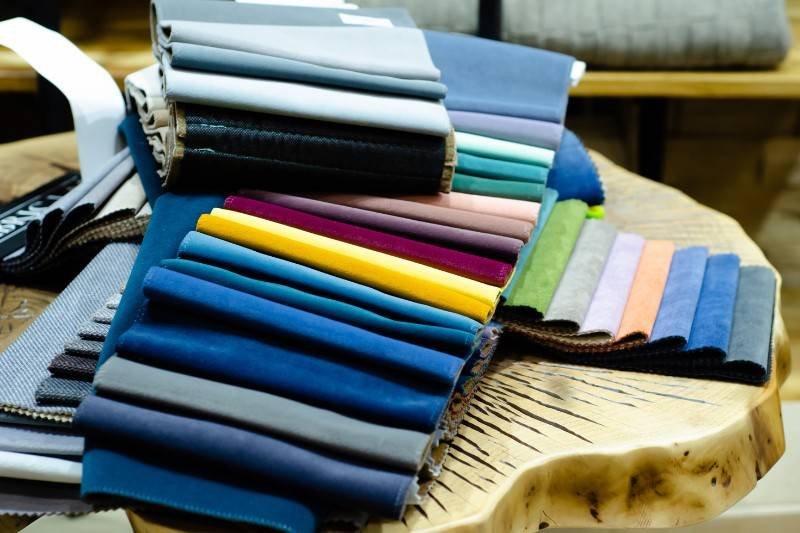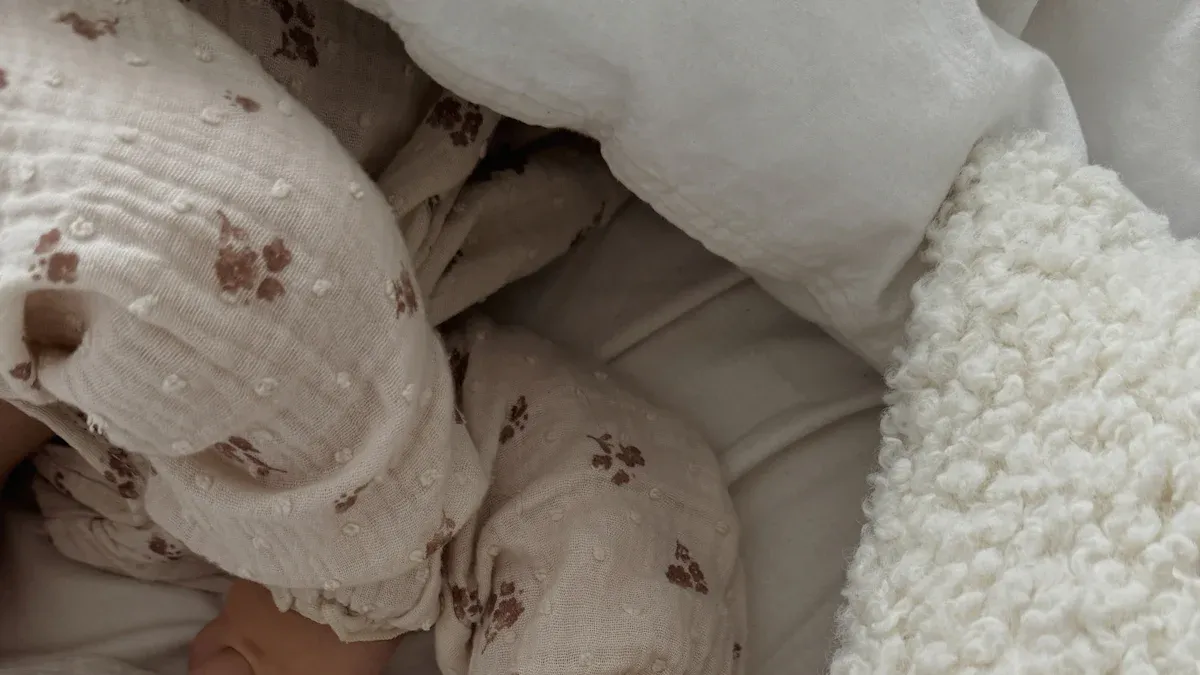
Is bamboo fabric sustainable? You might think so, with bamboo racing up to 60 feet in three months and storing four times more CO2 than similar trees. Check out these numbers:
Aspect | Bamboo | Other Woods |
|---|---|---|
Maturity Time | ~3 years | ~20 years |
Growth Rate | Up to 2 in/hr | N/A |
Biomass/Acre | 14 tons | 8 tons (pine) |
Oxygen Release | 35% more | N/A |
Bamboo fabric uses less water and grows fast, but not every bamboo fabric is eco-friendly. Chemical processing can impact how sustainable your pajamas really are. With greenwashing on the rise, you need to know what’s real and what’s just clever marketing.
Key Takeaways
Bamboo grows fast and uses less water, making it a more sustainable fabric source than many others.
The way the bamboo fabric is made matters: mechanical and lyocell processes are more eco-friendly than chemical viscose.
Look for trusted certifications like OEKO-TEX or GOTS to find truly eco-friendly bamboo pajamas.
Choose brands that share clear information about their fabric and production to avoid greenwashing.
Bamboo pajamas offer better comfort, durability, and temperature control compared to cotton and synthetics.
Is Bamboo Fabric Sustainable?
Environmental Impact
When you ask, “Is bamboo fabric sustainable?” you probably want to know how growing bamboo affects the planet. Bamboo grows incredibly fast. Some types, like Moso bamboo, can shoot up between 10 and 80 centimeters in a single day.
In just one to two months, these shoots reach full size. This rapid growth means you get more material in less time compared to trees or cotton.
Bamboo also needs less water than many other crops. Its underground rhizome network moves water efficiently from older plants to new shoots. This system helps bamboo thrive even when water is limited.
Market research shows that bamboo’s low water and land needs make it a popular choice for people who care about the environment.
You might wonder about the environmental impact of bamboo forests. Studies show that Moso bamboo forests can store 5.1 to 7.6 tons of carbon per hectare each year. That’s more than many rainforests.
About 70% of this carbon stays underground in the roots, acting as a long-term carbon bank. When you choose bamboo fabric, you help support a crop that can reduce greenhouse gases and fight climate change.
Bamboo products also have a lower global warming potential than steel, concrete, or plastic. Life cycle assessments show that most of the carbon footprint comes from the electricity used during processing, not from growing the bamboo itself.
When you pick bamboo pajamas, you support a material with real environmental benefits and minimal environmental impact.
Processing Methods
Now, let’s talk about how bamboo turns into fabric. This step matters a lot when you ask, “Is bamboo fabric sustainable?” There are two main ways to make bamboo fabric: mechanical and chemical processing.
Mechanical processing is sometimes called chemical-free processing. Workers crush the bamboo and use natural enzymes to break it down. This method creates bamboo linen, a strong, durable, and biodegradable fabric.
It keeps many of bamboo’s natural qualities, like being antibacterial and offering UV protection. Mechanical processing is labor-intensive and costs more, so you don’t see bamboo linen as often in stores.
Chemical processing is much more common. Factories use chemicals like lye, sulfuric acid, and carbon disulfide to dissolve bamboo into a pulp. This pulp then becomes bamboo viscose or rayon. Chemical processing is faster and cheaper, but it changes the fiber.
The finished fabric loses some of the bamboo’s natural properties, including its antibacterial effects. The Federal Trade Commission has pointed out that bamboo rayon does not keep the same antimicrobial qualities as raw bamboo.
In the past, chemical processing caused pollution, but new rules and better technology have helped reduce these problems.
You might see bamboo lyocell on some labels. This fabric uses a closed-loop process that recycles almost all the chemicals and water. It’s a more sustainable option than regular bamboo viscose.
Not all bamboo fabric is equally sustainable. The way the fabric is made—mechanical or chemical—makes a big difference. If you want the most environmentally friendly pajamas, look for bamboo linen or bamboo lyocell. These options use less harmful chemicals and keep more of bamboo’s natural benefits.
Tip: Always check the label or ask the brand about how their bamboo fabric is made. Choosing the right processing method helps you support a more sustainable future.
Types of Bamboo Fabric

When you shop for eco-friendly pajamas, you’ll notice several types of bamboo fabric. Each one has its own impact on the planet, feel, and price. Let’s break down the main options so you can make the best choice for your comfort and values.
Bamboo Linen
Bamboo linen stands out as the most sustainable bamboo fabric. Manufacturers use a mechanical process that combs and spins bamboo fibers with natural enzymes.
This method skips harsh chemicals and keeps more of bamboo’s natural qualities. The result is a strong, breathable fabric that feels a bit coarse but lasts a long time.
Bamboo linen avoids toxic chemicals.
It preserves bamboo’s natural antibacterial and UV-resistant properties.
The process is labor-intensive and costly, so you won’t see bamboo linen everywhere.
The Natural Resources Defense Council recommends bamboo linen, especially when it’s dew-retted and naturally dyed. Dew-retting uses less water and energy, making this bamboo fabric even more eco-friendly.
Fabric Type | Production Method | Eco Rating | Environmental Impact Summary |
|---|---|---|---|
Bamboo Linen | Mechanical (natural enzymes) | ★★★★★ | Avoids toxic chemicals, preserves natural bamboo qualities, environmentally friendly but labor-intensive and costly. |
Bamboo Lyocell
Bamboo lyocell offers a great balance between sustainability and softness. This bamboo fabric uses a closed-loop process that recycles almost all water and chemicals. You get a silky, smooth feel without the heavy environmental toll of traditional viscose. Bamboo lyocell often appears in luxury pajamas and bedding.
More eco-friendly than viscose.
Softer and more breathable than bamboo linen.
Costs more than viscose but less than bamboo linen.
Bamboo Viscose
Bamboo viscose is the most common bamboo fabric you’ll find in stores. Factories use a chemical process to turn bamboo into a soft, drapey material. This method is fast and affordable, so bamboo viscose pajamas usually cost less.
Widely available and budget-friendly.
The process uses chemicals like caustic soda, which can harm the environment if not managed well.
Some improvements in chemical recycling have made bamboo viscose better, but it still ranks lower for sustainability.
Fabric Type | Cost Characteristics | Availability Characteristics |
|---|---|---|
Bamboo Linen | Most expensive due to labor-intensive mechanical processing | Less common, limited availability compared to cotton |
Bamboo Lyocell | Eco-friendly, often found in luxury products, more costly than viscose | Growing steadily but still less stocked than cotton |
Bamboo Viscose | Most common bamboo fabric, generally less expensive than linen or lyocell | Less varied and less widely stocked than cotton |
Friendtex can help you create pajamas and home wear from any of these bamboo fabric types. Their expertise lets you choose the right blend of comfort, style, and sustainability for your brand or personal use.
Eco-Friendly Bamboo Pajamas

Certifications
When you shop for bamboo pajamas, certifications can help you spot truly eco-friendly options. Look for trusted labels like OEKO-TEX, GOTS, Fair Trade, bluesign, and SA8000. These certifications show that the bamboo fabric in your pajamas meets high standards for safety, ethical labor, and environmental care.
While these labels do not offer statistical proof of sustainability, they act as reliable indicators that brands take extra steps to protect both people and the planet. If you see these certifications on bamboo pajamas, you can feel more confident about your purchase.
Tip: Always check the product tag or website for these certifications before you buy new pajamas.
Responsible Sourcing
You want your bamboo pajamas to feel good and do good. Responsible sourcing means brands use bamboo fabric made with closed-loop processing, which recycles water and chemicals to reduce waste. This method helps keep the environment cleaner and makes your pajamas safer to wear.
Ethical labor practices also matter. Brands that care about their workers ensure fair wages and safe working conditions. When you choose pajamas from a company that values responsible sourcing, you support a better future for everyone involved.
Look for details about closed-loop processing.
Check if the brand mentions fair labor standards.
Friendtex, for example, partners with brands to create bamboo pajamas using responsible sourcing and expert manufacturing.
Brand Transparency
Transparency sets great brands apart. You deserve to know where your bamboo fabric comes from and how your pajamas are made. Many brands now share their sourcing and manufacturing methods because shoppers like you demand honesty. The bamboo apparel market keeps growing, with more people choosing sustainable and ethically sourced products each year.
This trend pushes brands to be open about their practices. When you see clear information about materials, factories, and supply chains, you know the brand values your trust.
Note: If a brand answers your questions and shares details about their bamboo pajamas, that’s a good sign you’re making an informed, eco-friendly choice.
Bamboo Pajamas vs Other Fabrics
Cotton
When you shop for pajamas, cotton often comes to mind first. Cotton feels soft and breathable, but it can lose its shape and softness after many washes. You may notice cotton pajamas start to pill or thin out over time. Bamboo pajamas, on the other hand, keep their softness and shape much longer.
If you compare bamboo vs cotton, you will see that bamboo fabric stands up to more wear and tear. Bamboo also offers better temperature regulation, keeping you cool in summer and warm in winter. Cotton absorbs moisture but does not wick it away as quickly as bamboo. This means you might feel damp or sticky in cotton pajamas on hot nights.
Synthetics
Synthetics like polyester and nylon are common in pajamas because they are cheap and easy to care for. These fabrics dry fast and resist wrinkles, but they do not breathe well. You might wake up feeling sweaty or uncomfortable because synthetics trap heat and moisture. Bamboo pajamas provide better temperature regulation and breathability.
They wick away moisture about 40% more effectively than cotton, and much better than most synthetics. Plus, bamboo’s natural resistance to bacteria helps keep your pajamas fresher for longer, while synthetics can hold onto odors.
Comfort and Durability
You want pajamas that feel great and last. Skin-friendly bamboo pajamas offer a smooth, soft touch that works well for sensitive skin. Parents often say their children sleep better in bamboo pajamas, especially if they have eczema or allergies.
Bamboo’s natural hypoallergenic properties and natural resistance to bacteria help reduce skin irritation and keep your pajamas cleaner between washes.
Bamboo pajamas also have better temperature regulation, so you stay comfortable all night. The fabric’s high tensile strength means your pajamas will not wear out quickly, giving you long-lasting value.
Tip: If you want pajamas that combine comfort, durability, and better temperature regulation, bamboo pajamas are a smart choice for your wardrobe.
Greenwashing and Red Flags
Greenwashing is everywhere in the bamboo fabric world. You want to make eco-friendly choices, but some brands use clever marketing to make their products look greener than they really are. Let’s break down the most common red flags so you can shop with confidence.
Misleading Claims
Some brands use vague or exaggerated language to make bamboo pajamas sound more sustainable than they are. Watch out for these common tactics:
Brands claim their bamboo fabric keeps all the natural benefits of bamboo, even when chemical processing removes those qualities.
Labels say “eco-friendly” or “green” without explaining how the product is actually made.
Companies market bamboo viscose as if it’s pure bamboo, hiding the fact that it’s a chemically processed fiber.
Some products cost more just because they use the word “bamboo,” even if the fabric is similar to regular rayon.
Retailers use bamboo’s fast growth and renewability as a selling point but skip over the environmental impact of turning bamboo into fabric.
In 2022, big retailers like Walmart and Kohl’s paid millions in settlements after the FTC found they misled shoppers by calling rayon products “bamboo.” These cases show how important it is to look past the buzzwords.
Lack of Certification
If you don’t see third-party certifications, that’s a big warning sign. Certifications like OEKO-TEX, GOTS, or FSC prove that a product meets strict environmental and ethical standards.
Without them, brands can make claims without proof. Products without certification often use vague language or skip details about how the fabric is made. This lack of transparency makes it hard for you to trust their sustainability promises.
No certification = no trustworthy proof.
Vague claims often hide harmful practices.
Third-party labels help you spot real eco-friendly products.
Overstated Benefits
Some brands promise more than they can deliver. You might see claims that bamboo pajamas are “100% natural,” “chemical-free,” or “completely biodegradable.” The truth is that most bamboo fabric—especially viscose—goes through chemical processing.
The FTC warns that unless a product is made from actual bamboo fiber, it should be labeled as “rayon made from bamboo.” If a brand makes big promises without details, take a closer look. Real sustainability comes with honesty, not hype.
Tip: Always check for clear information and trusted certifications before you buy. If something sounds too good to be true, it probably is.
How to Choose Sustainable Bamboo Pajamas
Choosing the right bamboo pajamas can feel overwhelming with so many options and claims out there. You want to make sure your new sleepwear is truly sustainable, safe, and comfortable. Here’s how you can shop smarter and avoid the greenwashing traps.
Checklist
Start with a simple checklist when you shop for bamboo pajamas. This step-by-step guide helps you focus on what matters most for both the planet and your comfort.
Check the Fabric Type
Look for labels that say bamboo linen or bamboo lyocell. These types use more sustainable processing methods. Bamboo viscose is common, but it’s less eco-friendly.Look for Certifications
Search for trusted certifications like OEKO-TEX, GOTS, or FSC. These show that the pajamas meet strict safety and environmental standards.Ask About Processing
Brands should tell you if they use closed-loop processing, especially for bamboo lyocell. This method recycles chemicals and water, making the fabric more sustainable.Review Brand Transparency
Choose brands that share details about their sourcing and manufacturing. If a company answers your questions and provides clear information, you can trust their eco-friendly claims.Consider Comfort and Fit
Make sure the pajamas feel soft, breathable, and fit your needs. Sustainable sleepwear should also help you sleep better.
Tip: Print or save this checklist on your phone. Use it while shopping online or in stores to make sure you pick the best bamboo pajamas for you and the planet.
Questions to Ask
Don’t be shy about asking brands direct questions. The answers can reveal a lot about how sustainable and safe their bamboo pajamas really are. Here are some smart questions to get you started:
What type of bamboo fabric do you use (linen, lyocell, or viscose)?
Can you explain your processing method? Is it closed-loop?
Do your pajamas have certifications like OEKO-TEX or GOTS?
Where do you source your bamboo, and who makes your products?
How do you ensure safe and ethical working conditions in your supply chain?
Asking these questions matters because not all bamboo fabrics are the same. Some use blends or chemicals that affect both quality and sustainability. Many manufacturers do not share processing details, so your questions help you avoid hidden risks.
Outdated equipment can even introduce harmful substances, like heavy metals, into the fabric. Certifications and independent lab testing are key to making sure your bamboo pajamas are safe and truly sustainable.
Here’s a quick table to show why asking questions is so important:
Reason to Ask Questions | What You Learn |
|---|---|
Fabric Type | Ensures you get the quality and sustainability you want |
Processing Method | Reveals if closed-loop or chemical-heavy methods are used |
Certifications | Confirms safety and environmental standards |
Transparency | Shows if the brand is honest and open |
Safety | Helps you avoid pajamas with harmful substances |
Note: The Federal Trade Commission requires brands to use accurate labeling. If a company can’t answer your questions, it’s a red flag.
Mindful Shopping
Mindful shopping means you think before you buy. You look past the marketing and focus on what really matters. When you shop for bamboo pajamas, take your time to read labels, check certifications, and ask questions. Don’t rush your decision just because something looks “green” or “eco-friendly.”
Research shows that closed-loop processing in bamboo lyocell production makes a big difference. This method recycles chemicals and water, reducing pollution and helping brands earn certifications like OEKO-TEX and GOTS.
These certifications prove that your pajamas are safer for you and better for the environment. Always look for these details when you shop.
You can also support brands that value transparency and responsible sourcing. Friendtex, for example, works closely with brands to create sustainable bamboo pajamas using advanced manufacturing and ethical practices.
When you choose pajamas from a company like this, you help build a more eco-friendly fashion industry.
Remember: Every purchase is a vote for the kind of world you want. Choose bamboo pajamas that match your values and help protect the planet.
Conclusion
You now know that bamboo fabric can be a sustainable choice when you pay attention to how it’s made. Use the checklist and tips from this guide to pick pajamas that match your values.
Always look for certifications and clear information from brands. > Remember, every purchase gives you the power to promote a greener future. Choose wisely and help make a real difference for the planet.
FAQ
What makes bamboo pajamas eco-friendly?
You want pajamas that help the planet. Eco-friendly bamboo pajamas use sustainable fabric, closed-loop processing, and safe dyes. Look for trusted certifications. Brands that share details about their sourcing and manufacturing usually offer better choices for you and the environment.
How do I care for bamboo pajamas?
Wash your bamboo pajamas in cold water on a gentle cycle. Use mild detergent. Skip bleach and fabric softeners. Air dry or tumble dry on low. This keeps your pajamas soft and helps them last longer.
Are bamboo pajamas safe for sensitive skin?
Yes, bamboo pajamas feel soft and gentle. They work well for sensitive skin. The fabric resists bacteria and wicks away moisture. Many parents choose bamboo baby clothing for these reasons.
Do bamboo pajamas shrink after washing?
Bamboo pajamas may shrink a little after the first wash. To avoid this, wash them in cold water and air dry. Always check the care label for the best results.
Can I find stylish bamboo pajamas for all ages?
You can find bamboo pajamas in many styles and sizes. Brands offer options for adults, kids, and even bamboo baby clothing. There are choices for every taste and need.


